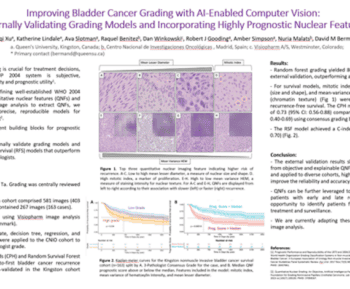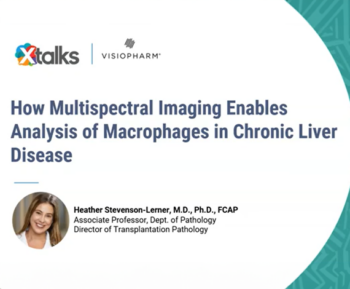

90% of breast cancer mortality is caused by distant metastasis, a process that involves both dissemination of cancer cells to distant sites as well as their proliferation after arrival. However, prognostic assays currently used in the clinic are based on proliferation and do not measure tumor cell dissemination potential. Based on intravital imaging of tumor cell dissemination in live animals, we previously reported two biomarkers for the development of distant metastasis: TMEM Score and MenaCalc. TMEM Score is based upon the density of Tumor Microenvironment of Metastasis (TMEM) doorways, portals for cancer cell intravasation and dissemination formed by the confluence of a Mena overexpressing tumor cell, a pro-angiogenic macrophage, and an endothelial cell. MenaCalc is a pattern of expression of the actin-regulatory protein Mena which leads tumor cells to undergo epithelial-to-mesenchymal transition (EMT) and become highly motile.
Using digital pathology, we analytically validated an automated analysis of TMEM doorways that reduced pathologist time by an order of magnitude and enabled the rapid clinical validation of TMEM Score. While TMEM score has been validated for prognosticating metastatic outcome in HR+/HER2- patients, statistical significance was not observed in patients with triple negative or HER2+ breast cancers. Furthermore, MenaCalc has been shown to be prognostic in some cohorts of patients with triple negative disease but the prognostic value of MenaCalc in HR+ disease is still unclear. Since TMEM doorways and MenaCalc are mechanistically linked (but independent) biomarkers, we investigated if a combined TMEM-MenaCalc biomarker can improve the prognostication ability of either biomarker alone. Again, using digital pathology, we evaluated several different methods of combining TMEM and MenaCalc scores to create a multiparameter quantitative analysis with dramatically improved prognostic ability for distant metastasis in breast cancer patients.
Presented as a LabRoots webinar on February 9, 2021.
-
- Discuss the process of tumor cell dissemination from breast tumors.
-
- Summarize how live imaging studies are able to discover mechanisms of metastasis which can then be turned into prognostic biomarkers for metastasis.
-
- Outline how digital whole slide scanning and digital pathology can be used to automate as well as analytically and clinically validate prognostic biomarkers.

David Entenberg, PhD, Assistant Professor, Department of Anatomy and Structural Biology, Albert Einstein College of Medicine
Dr. David Entenberg received his bachelor’s degree in physics at SUNY Stony Brook and his Masters’ degree in chemical physics from Weizmann Institute of Science in Israel. He then obtained his Ph.D. in cell biology from the University of Kent. In 2006 he brought his imaging expertise to Albert Einstein College of Medicine and now serves as the Director of Technology Development for Einstein’s Gruss Lipper Biophotonics Center and its associated Integrated Imaging Program. He also leads the development of novel and innovative imaging techniques that provide high-resolution visualization of the tumor microenvironment.



